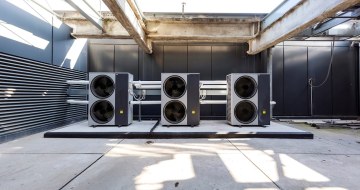
November 6, 2024 in Advisory Notes
Integrated Fire Mode Testing — Fundamental to Buildin...
Modern fire protection systems are now often integrated into other building systems and require a comprehensive testing approach to assure they will o...
March 18, 2021
Coronaviruses are a family of viruses that can cause illness to humans and animals. A new coronavirus known as COVID-19 was first reported on 31 December 2019 in Wuhan City in China.
Symptoms of the virus can range from mild illness to pneumonia. People with COVID-19 may experience fever, flu-like symptoms such as coughing, sore throat, fatigue and shortness of breath.
At the time of writing the transmission mechanisms are not fully understood. It is believed that the virus can be transmitted from person-to-person, most likely through close contact with an infectious person, or contact with droplets of fluid from an infected person’s cough or sneeze. It is also believed that transmission can occur by touching surfaces that have droplets from an infected person, and then touching the mouth or face. It is believed that the virus may survive for up to 9 days on some surfaces in the right conditions.
When a person infected with an illness coughs or sneezes, pathogens can be encapsulated within droplets of fluid and discharged into the air. Different illnesses are known to result in differing droplet sizes. It is not yet certain what size droplets are produced by people infected with COVID-19.
It is known that large droplets (>60 µm) normally are too large to remain suspended in the air and usually fall and land on surfaces. In some instances, some of the fluid can evaporate and the large droplets can transform into smaller particles called droplet nuclei and these can remain suspended in air. Droplet nuclei (2.5 to 10 µm) are believed to be able to remain suspended in air for hours and therefore be entrained into HVAC systems.
HVAC Systems Explained
Heating Ventilating and Air Conditioning (HVAC) systems exist in many formats. The diagram depicts a typical HVAC system commonly found in commercial and institutional buildings. It is fundamentally a recirculating system with a portion of outside air added continually whilst a similar portion is exhausted. The outside air rate can be varied in many systems. Air is filtered before recirculation and moved around the system using fans. Heating and cooling are typically provided by finned coils using heating or chilled water.
The journey that a virally infected droplet would experience to arrive back in an occupied space would typically include extended ducted air pathways, multiple changes in direction and air velocity, and multiple impacting surfaces including air filters, fans, dampers and grilles. There is a good likelihood that a particle would impact, entrain and dry on a surface.
Whilst published research on healthcare ventilation systems and scenarios suggests that the transmission of droplets containing viral material is theoretically possible in these situations, it is thought to be less likely in a well-designed and properly maintained typical HVAC system in a public setting.

There are a number of practical HVAC operational measures that can be addressed along with possible system changes to reduce the likelihood of a virus spreading including the following:
Maintenance Regimes and Essential Safety Measures
The continued application of good housekeeping and preventative maintenance regimes are imperative. HVAC maintenance should be carried out as prescribed by the recognised standards and maintenance procedures should be adhered to.
It is important to remember that in the majority of modern buildings, operating HVAC systems form part of the essential safety measures and are therefore required for occupancy. The scheduled statutory maintenance of these systems along with fire protection and other essential systems is mandatory.
Whilst facilities may scale down operations and occupancy as the COVID-19 situation evolves generally these essential safety systems must continue to be maintained in accordance with regulations to ensure the ongoing compliance of the buildings.
Building operators should confer with service providers if measures are being considered to preclude or restrict maintenance technicians from accessing buildings.
Air filters should be replaced as scheduled or more often as required. PPE (Personal Protective Equipment) including P2 mask or appropriately rated respirator, coveralls and gloves and should be worn by trained technicians when servicing dirty filters. After turning off the air handling unit, filters should be carefully removed to avoid dust or other particles being released into the air, and the dirty filters should be bagged and tied, and the bag disposed of in an appropriate waste disposal process. Surfaces should be cleaned to remove any residual particles. Service of washable air filters should be carried out with similar approved procedures and use of PPE.
Cleaning and Disinfection
Standard HVAC systems are typically very difficult to clean and disinfect effectively because of the lack of access to many of the system components and ductwork. Some systems in acute care health facilities or laboratories are designed to provide adequate access and other features to facilitate regular and effective cleaning.
In commercial HVAC systems air filters can be readily changed, and cooling and heating coil surfaces can be cleaned and disinfected using approved methods and chemicals. Most other features and surfaces in HVAC systems typically cannot be readily cleaned physically.
In HVAC systems that include wall mounted or console type induction type units or chilled beams it is practical to clean these units if required.
Fogging or fumigating using approved methods and chemicals for disinfection can be applied in facilities and HVAC systems that are designed for this treatment. Typically, these are in laboratories and some acute care areas. Fogging or fumigating is not recommended for normal facilities and standard HVAC systems that are not specifically designed for this treatment. It is very likely to be ineffective and may be hazardous in these situations.
System Commissioning and Operation, and Outside Air Rates
It is important to ensure that HVAC systems have been properly commissioned and are operating correctly. Commercial HVAC systems are typically designed to produce internal conditions with a relative humidity of 40 – 60% RH. Published research suggests that this humidity range may have a positive impact on virus deactivation, human susceptibility to virus’s and cross infection rates.
Minimum statutory outside air rates should be in place as a basic requirement. Increased ventilation (circulation) rates can assist in diluting contaminants in room air and potentially reduce the likelihood of infections. In systems with modulating outside air systems, or where adjustment is possible, increasing outside air rates may be possible. This will also require increasing the system’s exhaust air rate and will help dilute any contaminants in the circulating air.
It should be noted that increasing outside air rates and or ventilation rates will generally result in increased energy usage and in some circumstances may result in difficulties in the system maintaining the desired internal temperature and humidity conditions.
Air Filtration and Air Cleaning Options
Air filtration typically installed in standard HVAC systems will not be effective in filtering droplet nuclei or viruses, should these reach the filters. The addition of increased efficiency particle filtration is likely to reduce the airborne load of infectious particles.
HEPA (High Efficiency Particulate Arresters) filtration systems filter 99.999% of dust particles and airborne contaminants such as viruses and bacteria. These filters are typically used in hospital operating rooms, acute care areas and clean rooms. HEPA filters are unlikely to be a practical option for most existing HVAC systems due to their high pressure drop. Additionally, HEPA filters require specific housings and cannot be retrofitted as a direct replacement for traditional filter media.
Conventional air filters with an improved Minimum Efficiency Reporting Value (MERV) between 13 and 15 (F7 to F9) can reduce levels of droplet nuclei but are not likely to be effective at stopping any unattached virus particles. These filters could assist in reducing the likelihood of droplet nuclei from spreading and may be within the fan capabilities of existing systems.
As a general rule, efficient filters have higher pressure drops which can increase energy consumption, though advancements in technology mean this is not always true.
Another practical method of air cleaning is Ultraviolet Germicidal Irradiation (UVGI). UVGI technology involves the production of short wavelength light which is capable of disrupting the DNA of microorganisms including viruses. The effectiveness of ultraviolet radiation depends on the intensity of the light and the time period that a given pathogen is exposed to the light. Units are available as in-duct devices that are installed in ductwork or air handling units.
Summary of Recommendations
The risk of a well-maintained HVAC system in a modern commercial building causing transmission of the COVID-19 are understood to be low. There are however some practical measures that building owners and operators can take to further reduce the risk including:
Air filters should be changed, and cooling and heating coil surfaces can be cleaned and disinfected using approved methods and chemicals.
If the HVAC system includes induction type units or chilled beams, these units can be cleaned and disinfected using approved methods and chemicals.
Most other features and surfaces in HVAC systems typically cannot be readily cleaned physically.
Fogging or fumigating is not recommended for normal facilities and standard HVAC systems that are not specifically designed for this treatment.
HVAC systems can be used to assist in reducing the spread of infections, but there is only so much that can be achieved. The role of HVAC systems in controlling the transmission of infection should be considered a part of a broader multi-modal infection control strategy in buildings.
For more information on HVAC and COVID-19 please contact:
Matthew Peacock
Senior Mechanical Engineer, A.G. Coombs Advisory
P: +61 3 9248 2700 | E: mpeacock@agcoombs.com.au
References and Resources
Airepure. 2015: Filter Efficiency – Cross Reference Guide of Filter Efficiencies. Melbourne, Victoria, Australia. https://www.airepure.com.au/products/airepure-filter-efficiency-guide/. 18 March 2020 .
American Society for Microbiology. Effects of Air Temperature and Relative Humidity on Coronavirus Survival on Surfaces. Lisa M. Casanova, Soyoung Jeon, William A. Rutala, David J. Weber, Mark D. Sobsey. https://aem.asm.org/content/76/9/2712.short. March 2010
American Society of Heating, Refrigerating and Air-Conditioning Engineers (ASHRAE). The ASHRAE Position Document on Airborne Infectious Diseases., Atlanta, Georgia, USA; Reaffirmed by Technical Council, https://www.ashrae.org/, 5 February 2020.
American Society of Heating, Refrigerating and Air-Conditioning Engineers (ASHRAE). ASHRAE Standard 52.2-2012, Method of Testing General Ventilation Air-Cleaning Devices for Removal Efficiency by Particle Size. Atlanta, Georgia, USA. https://www.ashrae.org/. Published 2012
Australian Institute of Refrigeration Air conditioning and Heating (AIRAH). Application Manual DA8, HVAC&R An Introduction. https://www.airah.org.au/ItemDetail?iProductCode=DA08. Published 1998.
Commonwealth Government of Australia. Coronavirus (COVID-19) resources. https://www.health.gov.au/resources/collections/novel-coronavirus-2019-ncov-resources. 18 March 2020
New England Journal of Medicine. A Novel Coronavirus from Patients with Pneumonia in China, 2019. https://www.nejm.org/doi/full/10.1056/NEJMoa2001017. Published 20 February 2020,
New South Wales Government. Novel coronavirus (COVID-19) – Frequently asked questions. https://www.health.nsw.gov.au/Infectious/alerts/Pages/coronavirus-faqs.aspx. 18 March 2020.
World Health Organization. 2020: Coronavirus disease (COVID-19) advice for the public. https://www.who.int/emergencies/diseases/novel-coronavirus-2019/events-as-they-happen. 18 March 2020.
Published March 2020. While every effort has been made to ensure the accuracy of information in this publication, the A.G. Coombs Group assumes no responsibility for errors or omissions for any consequence of reliance on this publication.
download pdf
November 6, 2024 in Advisory Notes
Modern fire protection systems are now often integrated into other building systems and require a comprehensive testing approach to assure they will o...

August 8, 2024 in Advisory Notes
Over the past decade, automated data analytics have been seamlessly integrated into various facets of our daily lives, including the operation and mai...

June 24, 2024 in Advisory Notes
Mould plays an important role in the natural environment as a break-down mechanism for dead organic matter. In the built environment it is an unwanted...

April 30, 2024 in Advisory Notes
A lot has changed since A.G. Coombs released our first Advisory Note on heat pumps back in 2018. Increasingly, asset owners are no longer asking if he...